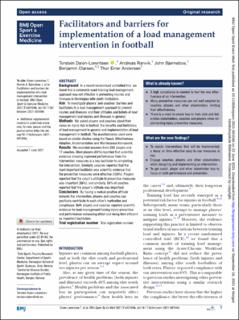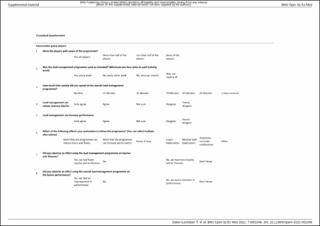| dc.contributor.author | Dalen-Lorentsen, Torstein | |
| dc.contributor.author | Ranvik, Andreas M. | |
| dc.contributor.author | Bjørneboe, John Andreas | |
| dc.contributor.author | Clarsen, Benjamin Matthew | |
| dc.contributor.author | Andersen, Thor Einar | |
| dc.date.accessioned | 2021-09-22T12:17:59Z | |
| dc.date.available | 2021-09-22T12:17:59Z | |
| dc.date.created | 2021-06-28T12:00:14Z | |
| dc.date.issued | 2021 | |
| dc.identifier.citation | BMJ Open Sport & Exercise Medicine. 2021, 7(2), Artikkel e001046. | en_US |
| dc.identifier.issn | 2055-7647 | |
| dc.identifier.uri | https://hdl.handle.net/11250/2780329 | |
| dc.description | This is an open access article distributed in accordance with the Creative Commons Attribution Non Commercial (CC BY-NC 4.0) license, which permits others to distribute, remix, adapt, build upon this work non-commercially, and license their derivative works on different terms, provided the original work is properly cited, appropriate credit is given, any changes made indicated, and the use is non-commercial. | en_US |
| dc.description.abstract | Background: In a recent randomised controlled trial, we found that a commonly used training load management approach was not effective in preventing injuries and illnesses in Norwegian elite youth footballers.
Aim: To investigate players’ and coaches’ barriers and facilitators to a load management approach to prevent injuries and illnesses and their attitudes and beliefs of load management and injuries and illnesses in general.
Methods: We asked players and coaches about their views on injury risk in football, the benefits and limitations of load management in general and implementation of load management in football. The questionnaires used were based on similar studies using the Reach, Effectiveness, Adoption, Implementation and Maintenance framework.
Results: We recorded answers from 250 players and 17 coaches. Most players (88%) reported that scientific evidence showing improved performance from the intervention measures is a key facilitator to completing the intervention. Similarly, coaches reported that the most important facilitator was scientific evidence that the preventive measures were effective (100%). Players reported that the coach’s attitude to preventive measures was important (86%), and similarly, 88% of coaches reported that the player’s attitude was important.
Conclusions: By having a mutual positive attitude towards the intervention, players and coaches can positively contribute to each other’s motivation and compliance. Both players and coaches reported scientific evidence for load management having injury-preventive and performance-enhancing effect and being time efficient as important facilitators. | en_US |
| dc.language.iso | eng | en_US |
| dc.subject | football | en_US |
| dc.subject | implementation | en_US |
| dc.subject | prevention | en_US |
| dc.title | Facilitators and barriers for implementation of a load management intervention in football | en_US |
| dc.type | Peer reviewed | en_US |
| dc.type | Journal article | en_US |
| dc.description.version | publishedVersion | en_US |
| dc.rights.holder | © Author(s) (or their employer(s)) 2021 | en_US |
| dc.source.pagenumber | 9 | en_US |
| dc.source.volume | 7 | en_US |
| dc.source.journal | BMJ Open Sport & Exercise Medicine | en_US |
| dc.source.issue | 2 | en_US |
| dc.identifier.doi | 10.1136/bmjsem-2021-001046 | |
| dc.identifier.cristin | 1918857 | |
| dc.description.localcode | Institutt for idrettsmedisinske fag / Department of Sports Medicine | en_US |
| dc.source.articlenumber | e001046 | en_US |
| cristin.ispublished | true | |
| cristin.fulltext | original | |
| cristin.qualitycode | 1 | |

